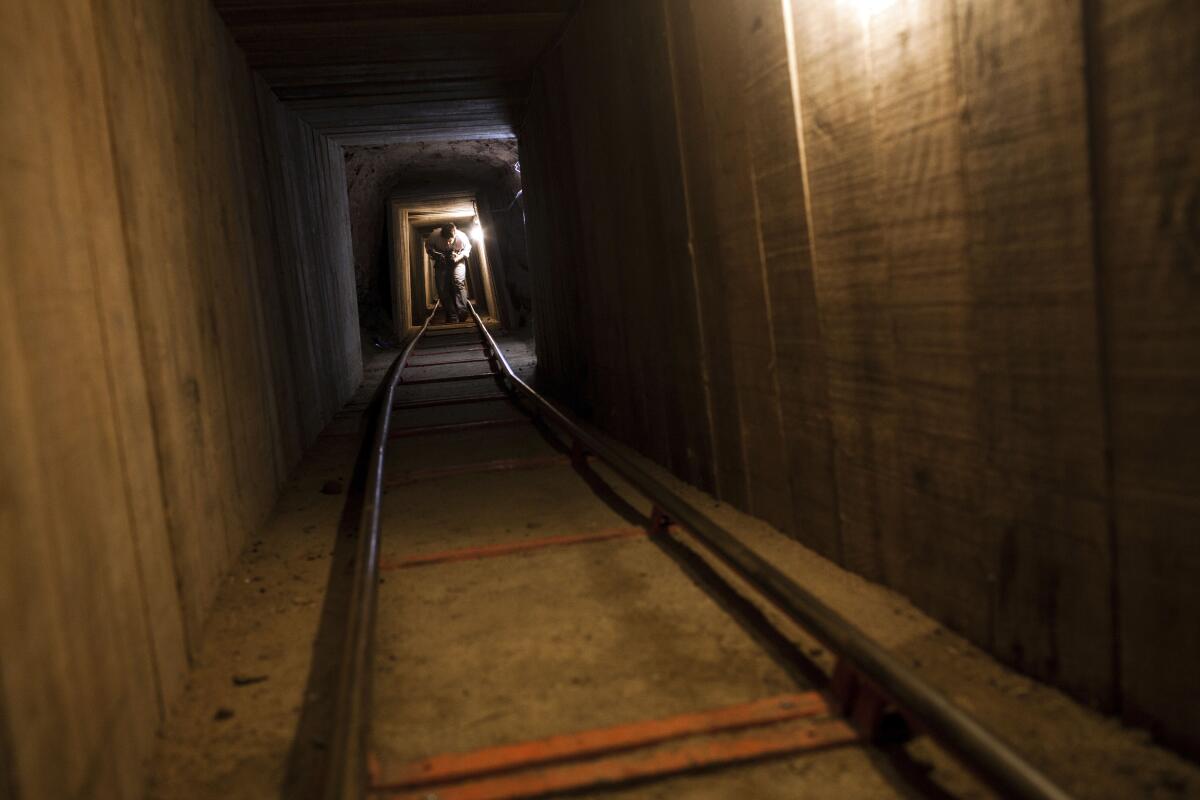Architect of ‘El Chapo’s’ cross-border narco tunnels sentenced to 10 years

- Share via
SAN DIEGO — The tunnel linking a Tijuana warehouse to another in Otay Mesa was equipped with a hydraulic elevator, electric rail cars, lighting, wooden floors and a storeroom.
The subterranean passage discovered in 2011 was designed to secretly move tons of marijuana north — a feat of engineering that U.S. authorities would later marvel at as the “most elaborate smuggling tunnel” to be uncovered along the U.S.-Mexico border at the time.
It was the work of Jose Sanchez Villalobos, one of the Sinaloa cartel’s high-level managers, whose efforts continued to raise the profile on drug kingpin Joaquín “El Chapo” Guzmán’s obsession with underground routes.
On Wednesday, Sanchez was sentenced in San Diego federal court to 10 years and one month in custody for a drug-distribution conspiracy — just over the 10-year minimum mandatory sentence.
In a plea agreement in December, Sanchez admitted to planning, financing and supervising the construction of multiple cross-border tunnels from 2010 to 2012, as well as overseeing their operation as smuggling conduits.
During the hearing, U.S. District Judge Michael Anello acknowledged Sanchez’s “very sophisticated criminal conduct at a very high level” but also noted he was “a totally different man today than when the conduct was committed.”
Sanchez, 58, has already served most of his prison term. Since his arrest in Mexico in 2012, he has spent about eight years in custody there and another year and a half in San Diego, after being extradited to face charges in the U.S. With good behavior credits, he is likely due to be released within a few months.
According to a sentencing memorandum prepared by his defense attorney, Sanchez was born in Atequiza in Mexico’s Jalisco state, and worked as a child on his family’s farm with 10 siblings.
He immigrated to Los Angeles in his early 20s, staying for the next two decades. He returned to Guadalajara in 2005.
The documents don’t reveal how Sanchez became entangled with the Sinaloa cartel or rose to become one of Guzmán’s tunnel architects. He was known by a string of nicknames — Quirino, Garañón, El Gato, El Viejo, Primo, Greñudo — which at times confounded investigators trying to learn his identity, according to a 2015 article in the New Yorker.
U.S. authorities described Sanchez as a regional manager for the cartel in the states of Baja California and Jalisco, overseeing the movement of marijuana from southern Mexico to northern Mexico.
He was responsible for building the tunnels that the marijuana moved through, as well as determining who would be able to smuggle through them, authorities said. He charged fees to traffickers for the privilege of using the underground routes, officials said.
Tunnels have long been a preferred method to smuggle marijuana; its bulk and smell make smuggling in vehicles through ports of entry more challenging than other drugs. The probation officer who prepared Sanchez’s pre-sentencing report noted that “it does not appear ‘harder’ drugs like cocaine, heroin or methamphetamine were funneled through” the tunnels.
While Sanchez admitted to orchestrating several tunnel networks, his indictment and plea agreement single out two.
Both were in Otay Mesa, an expanding warehouse district along the border in San Diego with ideal conditions for tunneling. For starters, the soil, a mixture of volcanic ash and clay, is perfect for digging: soft enough to get through but firm enough to hold its shape. Plus, the warren of warehouses — where loud noises and round-the-clock truck traffic are routine — provided ample cover for a major trafficking operation.
One tunnel was discovered on Nov. 25, 2010. It ran for 2,200 feet, starting at a Tijuana home and exiting at a set of warehouses on Marconi Drive. The passage was noted for its complexity, with a rail system, tongue-and-groove flooring and ventilation.
About 3,500 kilograms of marijuana was seized in the warehouse, and further investigation led to a tractor-trailer laden with another 12,500 kilograms at the Interstate 15 Border Patrol checkpoint in Temecula. A kilogram is 2.2 pounds.
The second tunnel, which U.S. authorities said was even more sophisticated, was found Nov. 29, 2011, at a warehouse on Calle de Linea. Agents seized 15,000 kilograms of marijuana inside the warehouse, and an additional 10,600 kilograms from a tractor-trailer that had loaded up and driven to the City of Industry, according to the plea agreement.
Sanchez, a legal permanent U.S. resident, will likely be deported to Mexico once released from prison. He plans to return to Guadalajara and undergo surgery to address serious health issues, according to his attorney, Guadalupe Valencia.
During the hearing, Sanchez apologized for his conduct through a Spanish interpreter: “I promise I will not do anything illegal again, because the easy way to get money is usually the bad way to get it.”
Davis writes for the San Diego Union-Tribune.
More to Read
Sign up for Essential California
The most important California stories and recommendations in your inbox every morning.
You may occasionally receive promotional content from the Los Angeles Times.














